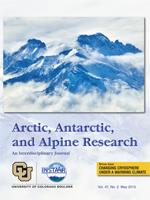The spatial distribution of the snow water equivalent (SWE) of ground snow cover is one of the most important variables for understanding and simulating cold-region hydrological processes in high mountain areas. In this paper, the characteristics of C-band synthetic aperture radar (SAR) data in an area of shallow dry snow cover were analyzed based on microwave backscattering models and field snow cover measurements. The analysis revealed that the backscattering of shallow dry snow cover was dominated by the scattering of the snow-ground interface, and the dielectric constant and roughness parameters of the underlying frozen soil were the primary factors that affected the total scattering. The dielectric constant of the soil depended on the amount of liquid water present in the soil, and the amount of liquid water was primarily determined by the soil temperature. Furthermore, the insulation properties (thermal resistance) of the snow cover affected the underlying soil temperature. Consequently, the snow cover characteristics affected the backscattering signal recorded by the SAR sensors. Based on an investigation involving ENVISAT-ASAR data and simultaneous ground-based snow observations conducted on 14 March 2008, we found that the snow temperature decreased with increasing snow depth when the snow depth was less than 20 cm, and the temperature increased with decreasing snow depth when the snow depth exceeded 20 cm. Additionally, the amount of liquid water in the underlying frozen soil rapidly increased with increasing temperature. To estimate the SWE, we used a small number of field measurements data and SAR ratio images to develop two equations. The first equation defined the relationship between the snow's thermal resistance and backscattering ratio, and the second equation yielded the SWE from the estimated thermal resistance of the snow-covered area. The root mean square and relative errors of the estimated SWE were approximately 7.41 mm and 6.17%, respectively. The derived SWE also indicated that blowing snow and sun radiation were two primary factors that determined the spatial distribution of snow cover in mountainous areas.
How to translate text using browser tools
1 May 2015
Estimation and Analysis of Snow Water Equivalents Based on C-Band SAR Data and Field Measurements
Shaobo Sun,
Tao Che,
Jian Wang,
Hongyi Li,
Xiaohua Hao,
Zengyan Wang,
Jie Wang





